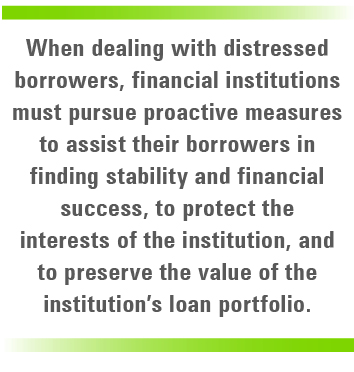By Richard Herold, Jacob Sparks, and W. Brian Memory
The COVID-19 pandemic necessarily expands the list of factors any lender must consider when enforcing the terms and conditions of its loan documents. There is a vast distinction between a corporate borrower who has looted the company and diverted corporate assets for personal gain and a corporate borrower whose business has been explicitly shut down by a gubernatorial pandemic order or forced into bankruptcy by a reduction or elimination or revenue. In short, a tailored approach to each borrower is always essential, but even more so now.
As borrowers struggle with reduced cash flows, depreciated collateral values, supply chain disruptions, changes in consumer shopping behavior, and new health and safety practices that constrain capacity and productivity, lenders will likely continue to receive a higher volume of borrower requests for forbearances, loan modifications, or other accommodations. When dealing with distressed borrowers, financial institutions must pursue proactive measures to assist their borrowers in finding stability and financial success, to protect the interests of the institution, and to preserve the value of the institution’s loan portfolio.
Reviewing the Loan Documents for Potential Deficiencies
Financial institutions should begin by collecting and reviewing all documents, including correspondence, relating to the loan. Documents should be preserved, well-organized and made easily accessible.
Lenders should confirm they have all required documentation and necessary signatures, and that the documents are otherwise free of errors or other deficiencies that could impact the financial institution’s position. Workout situations provide an invaluable opportunity for the lender to resurrect missing documents, to cure document deficiencies and to address drafting errors.

Lien Perfection and Priority
A lien perfection and priority analysis is a critical part of any loan file review. This is a great time for the lender to confirm it has a properly perfected lien on collateral and its perfected lien is first in priority among any other existing creditors by reviewing the UCC financing statements to ensure the debtor’s name is correct, the UCC-1 was filed in the proper jurisdiction and the collateral has been correctly described.
Entering Into Pre-Negotiation Agreements
Prior to engaging in workout discussions, financial institutions should consider entering into pre-negotiation agreements with borrowers and guarantors in which, among other things, they acknowledge any existing defaults and agree that no oral or written statements will be binding on any party unless a formal written agreement approved by the financial institution is formally signed by all parties. It must be clear in that pre-negotiation agreement that an exchange of emails is insufficient to bind the lender.
Analyzing the Terms of Any Loan Workout Agreement
Workout agreements — whether a forbearance, modification, deferral or other similar agreement — create an opportunity for the financial institution to make the best of what might otherwise be an unfortunate situation for all parties. Financial institutions have a vested interest in helping borrowers obtain stability and achieve financial success while protecting the interests of the financial institution.
Although there are a plethora of issues to consider and opportunities to achieve these goals, the following are highlighted:
- Information Gathering. Lenders should use this opportunity to gather as much current data as possible. A field audit of current inventory, accounts receivable, and equipment is prudent to obtain current valuations of collateral and to verify the accuracy of the borrower’s reporting. The information-gathering may also help the financial institution recognize strengths or weaknesses in the borrower’s business, its management team or its industry
generally. For example, has the entire industry been shut down by an explicit gubernatorial order, precluding any revenue? - Additional Collateral. The financial institution might feel more comfortable making certain accommodations to the borrower in exchange for additional collateral. When available, a lender can obtain liens on unencumbered assets or second liens on encumbered assets. If the lender takes a lien on encumbered collateral, an intercreditor agreement with the other lienholder may be a useful step.
- Pledge Agreement. If the borrower is a partnership or limited liability company, the lender should assess the desirability of requiring an equity interest pledge. Likewise, if the borrower is a corporation, the lender should consider requiring a stock pledge. In either situation, experienced counsel can help the lender perfect a security interest in the pledged collateral.
- Deposit Accounts. If the lender is not the bank with which the borrower’s deposit account is maintained, the lender can obtain control of the borrower’s deposit account through a deposit account control agreement. If a default occurs later, the lender will then be able to instruct the borrower’s bank to pay the balance of the borrower’s deposit account to the lender.

Litigation of the Issues
Despite the lender’s best efforts, it may become necessary to litigate by (1) seeking to appoint a receiver to protect and preserve the collateral, (2) pursuing a trustee’s sale, (3) conducting a fair market value hearing to address the amount of the deficiency due and owing to the lender, or (4) defeating any counterclaims asserted by the borrower or guarantors. This can and should be a professional and orderly process, yet frivolous (and occasionally well-founded) affirmative defenses and counterclaims can delay interim judicial decisions and the final resolution of the case.
There is, of course, no reason to spend a great deal of time and money litigating the issues if the defendants will not be able to satisfy any judgment. Ask for an affidavit of financial condition, cross-check it with an independent asset search, and let the lender make a business judgment on the value of continued litigation.
And don’t overlook the value of mediation. Sure, it is a meaningful investment, but the case may be resolved, with finality, by the consent of the parties, in the course of one day, rather than over the next 12-24 months.
Chapter 11 Reorganization under the United States Bankruptcy Code
Ultimately, some borrowers will seek protection under the United States Bankruptcy Code. A predictable effect of the economic devastation wreaked by the coronavirus is that bankruptcy filings are on the rise, and lenders need to be aware of how the Small Business Reorganization Act of 2019 (SBRA) will change the bankruptcy landscape in certain Chapter 11 bankruptcy cases. The SBRA is a new debtor-friendly fast-track bankruptcy option that will alter the dynamic of negotiations between banks and their small business borrowers who file bankruptcy under Chapter 11.
The SBRA went into effect in February 2020 and modified traditional Chapter 11 practices and procedures with the intention of creating a faster, more efficient Chapter 11 process for small business debtors. For example, the SBRA requires debtors to attend a case status conference within 60 days and file a plan within 90 days. At least 14 days before the status conference, debtors are required to file a case status report detailing the debtor’s efforts to obtain a consensual plan. Debtors are not required to file a separate disclosure statement, but the plan must include a brief history of the debtor, a liquidation analysis, and financial projections relating to the debtor’s ability to make payments under the proposed plan of reorganization.
It is worth noting that debtors whose entire industry has been shuttered by the orders of state governors have had success asking for more time to propose a plan of reorganization on the theory that neither any financial projection nor any reorganization plan can be generated until revenues return.
Perhaps the most notable characteristic of the SBRA is that it allows, under certain circumstances, a debtor to “cram down” a non-consensual plan of reorganization. Under the SBRA, only the debtor can file a reorganization plan, and the court can confirm a debtor’s plan without the support of any class of claims as long as the plan is deemed to be fair and equitable with respect to each class of claims and does not discriminate unfairly.
Furthermore, the “absolute priority rule” does not apply to SBRA cases. Typically, when a Chapter 11 plan does not propose to pay creditors in full, equity owners lose their ownership interest unless they provide new value to fund the plan of reorganization. The SBRA, however, allows for confirmation of a Chapter 11 plan that maintains pre-bankruptcy ownership while discharging the reorganized debtor’s unpaid debts, as long as the debtor’s plan meets the SBRA’s plan confirmation requirements. To offset this advantage, lenders should consider taking a lien on owners’ equity as part of any pre-bankruptcy workout agreement.
Because plans of reorganization under the SBRA may only be filed by the debtor, can be confirmed without any class of creditors voting in favor of the plan, and are not subject to the absolute priority rule, prepared debtors with valuation evidence and financial forecasts may be able to quickly confirm a “cram down” plan. Therefore, lenders confronted with SBRA cases must be prepared to act quickly to engage counsel, participate in negotiations with the debtor and trustee to explore the terms of a consensual plan, and to establish and defend the bank’s claims and liens.

Conclusion
During challenging economic times, financial institutions need to work proactively with borrowers on commercial loan workouts that are, to a degree at least, of value to both the institution and the borrower. In doing so, lenders should take the opportunity to analyze loan documents, identify potential issues, and strengthen the lender’s position during the workout process. To the greatest extent possible, lenders should also use the workout process to obtain or to replace missing documents, cure document deficiencies, fix drafting errors and obtain additional security. Finally, if a borrower files bankruptcy under Chapter 11, the lender needs to be aware of recent changes brought about by the SBRA and act quickly to protect its rights.
Richard Herold, Jacob Sparks and W. Brian Memory, Spencer Fane LLP
This story appears in Issue 3 2020 of The Arizona Banker Magazine.








